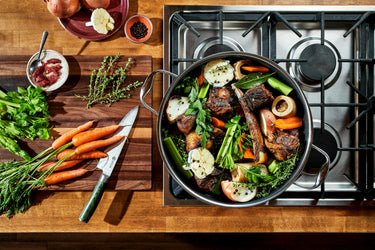What is Mirepoix?

POV: You’ve just gotten into cooking, you've set yourself up with a solid new set of pans, and you’re excited to get going on a beautiful stew on a chilly winter night.
Then you see the words in the recipe: Make the mirepoix.
Cue dread. The mire-what? Mirepoix (pronounced meer-PWAH) is a French term for the diced aromatic vegetables that comprise the base of beloved dishes such as coq au vin, bone broth and chicken and dumplings.
Classic French technique combines carrot, celery and onion to cook over medium-low heat in butter or oil so the vegetables “sweat” out the moisture and cook without browning. Key to a traditional French mirepoix is a 2:1:1 ratio of onion to carrots and celery, e.g. 2 cups onion to 1 cup each carrots and celery.
Don’t worry too much about getting this ratio exactly right when cooking at home. What’s more important is trying to cut the vegetables into relatively even pieces. Choose a fine dice for short cooking times or when you want the mirepoix to break down during cooking and melt into the broth of a chicken stew, for instance. Opt for a bigger chop for long cooking times, such as in braises and stews. (We wouldn't judge you for running the veggies through the chopping blade on your processor, if you want to make quick work of it.)

France isn’t the only culture that employs a combination of aromatics in their classic dishes. Check out these variations from around the world:
- Italian soffritto: Known as “battuto” when raw and “soffritto” once cooked, the Italian flavor base adds garlic and fennel to the French combination of onion, carrot, and celery. You might see cubes of guanciale in there, if you’re in Umbria, or a sprinkle of hot peppers in southern Italy. Soffritto forms the base of classic Italian dishes like minestrone, ragù Bolognese, or ribollita, aka Tuscan bread soup. (You’ll find a version of it in our Brothy Tuscan Cannellini Beans & Greens recipe.)

- Spanish sofrito: Though the name is similar, Spanish sofrito differs quite a bit from the Italian version. It’s more of a sauce than a vegetable base for dishes, and forms the base of famous Spanish dishes like paella. There are onions in Spanish sofrito, but carrots and celery are jettisoned in favor of peppers, tomato paste (or canned tomatoes), garlic and spices like paprika and oregano.
- Cajun and Creole Holy Trinity: Hailing from Louisiana and its environs, Cajun and Creole cuisine has its own riff: equal parts onion, green bell pepper and celery. You might see recipes including shallots, scallions, parsley and garlic, too. The "holy trinity," as it's known, forms the base of rice dishes like jambalaya or red beans and rice and is combined with roux to make soups like gumbo or stews like crawfish étoufée.
- German suppengrün: At German farmers’ markets and grocery stores, you’re likely to see a bundle of “soup greens” (or pot vegetables) tied together, ready to chop and cook in the recipe of your choice. Normally, this combines carrots, parsley, and celery, celery root, and leeks and forms the base of braised dishes like Sauerbraten or traditional German soups like Kartoffelsuppe (potato soup) and Ochsenschwanzsuppe (oxtail soup). An onion would feel at home in a German-style soup, too, as would a parsnip.
- Nigerian ata lilo: Ata lilo is a combination of mild and spicy red peppers, tomatoes, and onions. This pepper mix forms the base of many Nigerian dishes such as jollof rice, ofada stew, and efo riro. Don’t skimp on the heat with the peppers you choose for your ata lilo: a scotch bonnet or bird's eye chili is essential.
Ready to get cracking? Brush up your chopping by reading 5 Next-Level Knife Skills To Make You A Better Cook in 2024.





